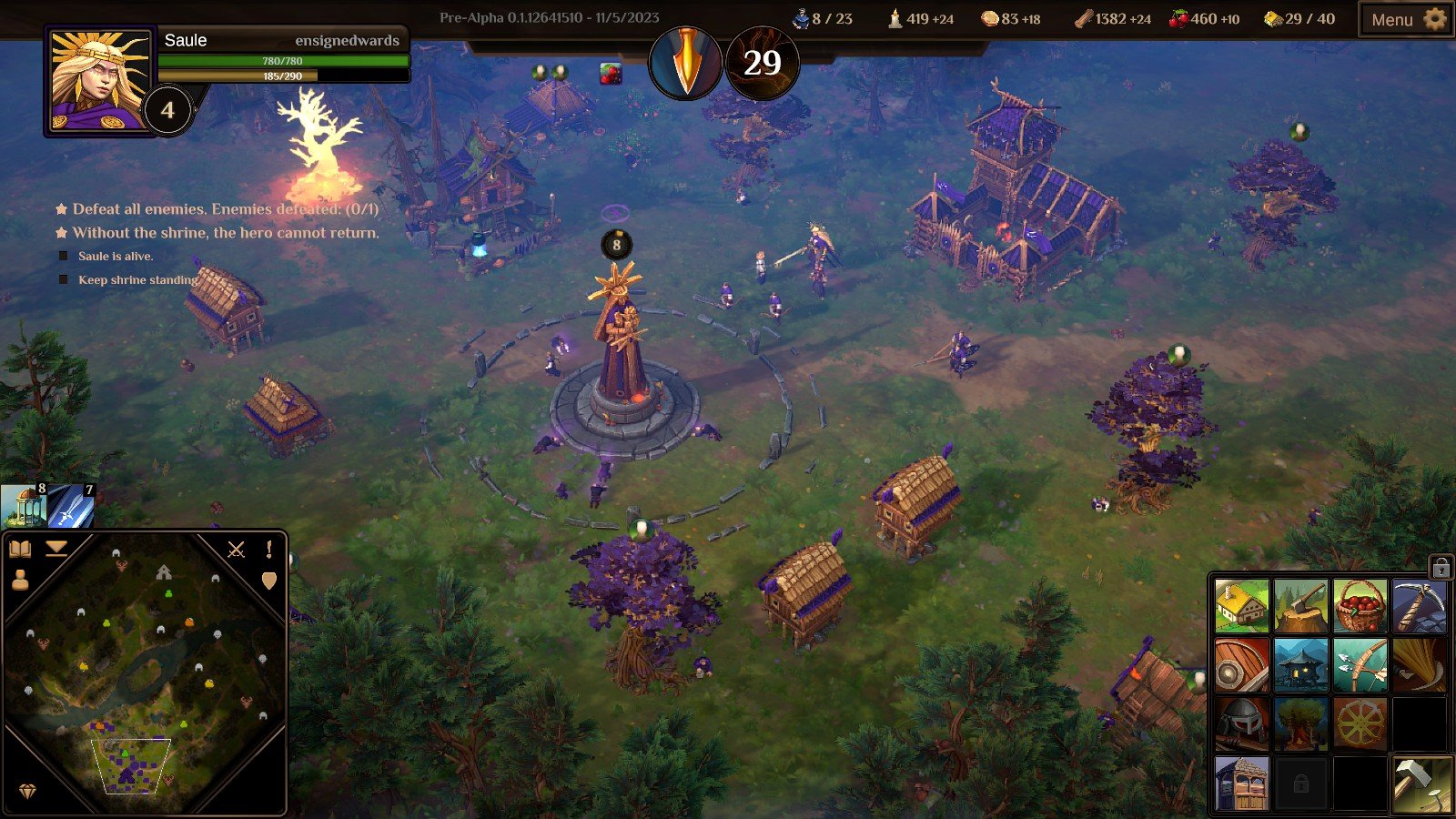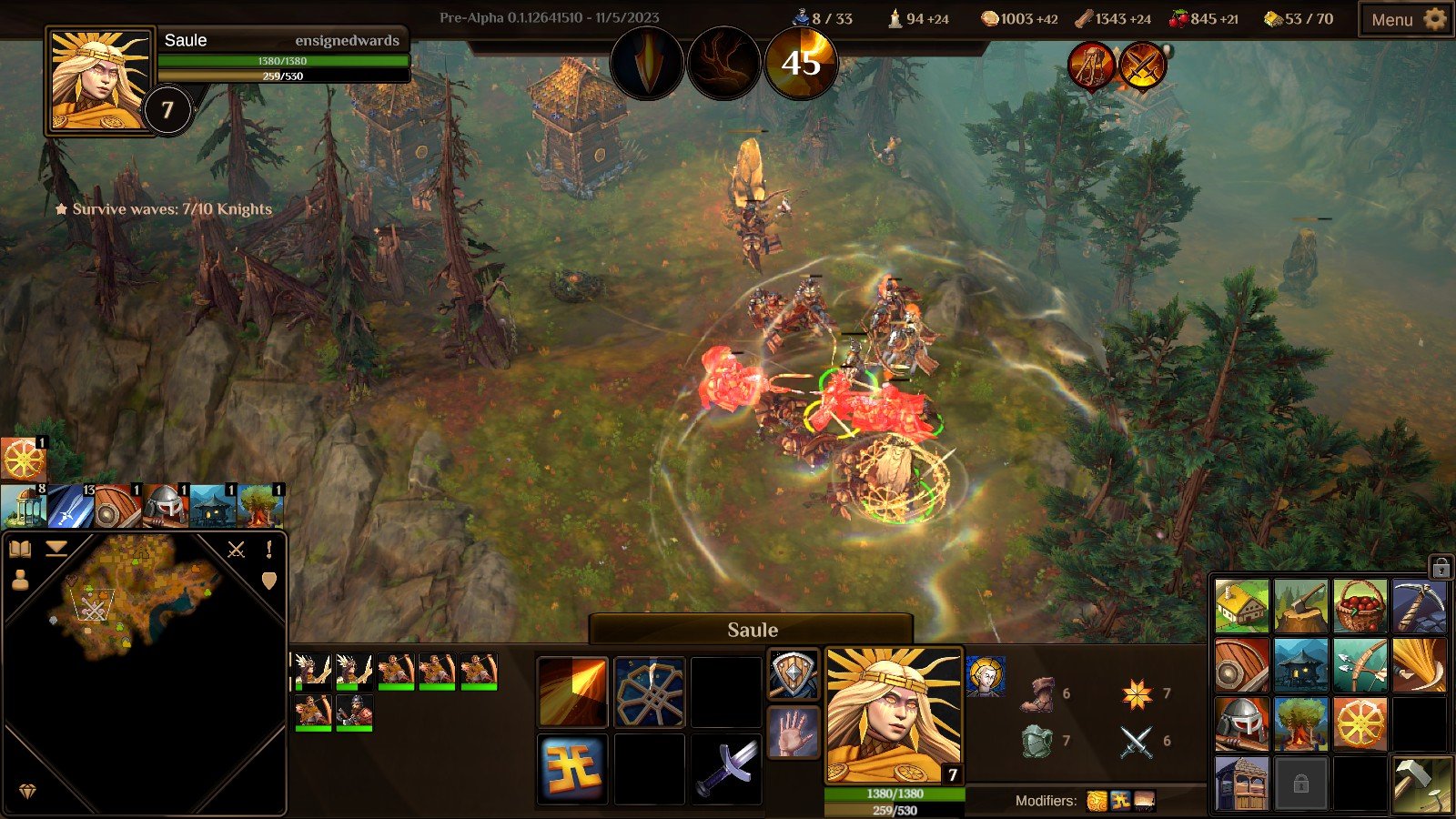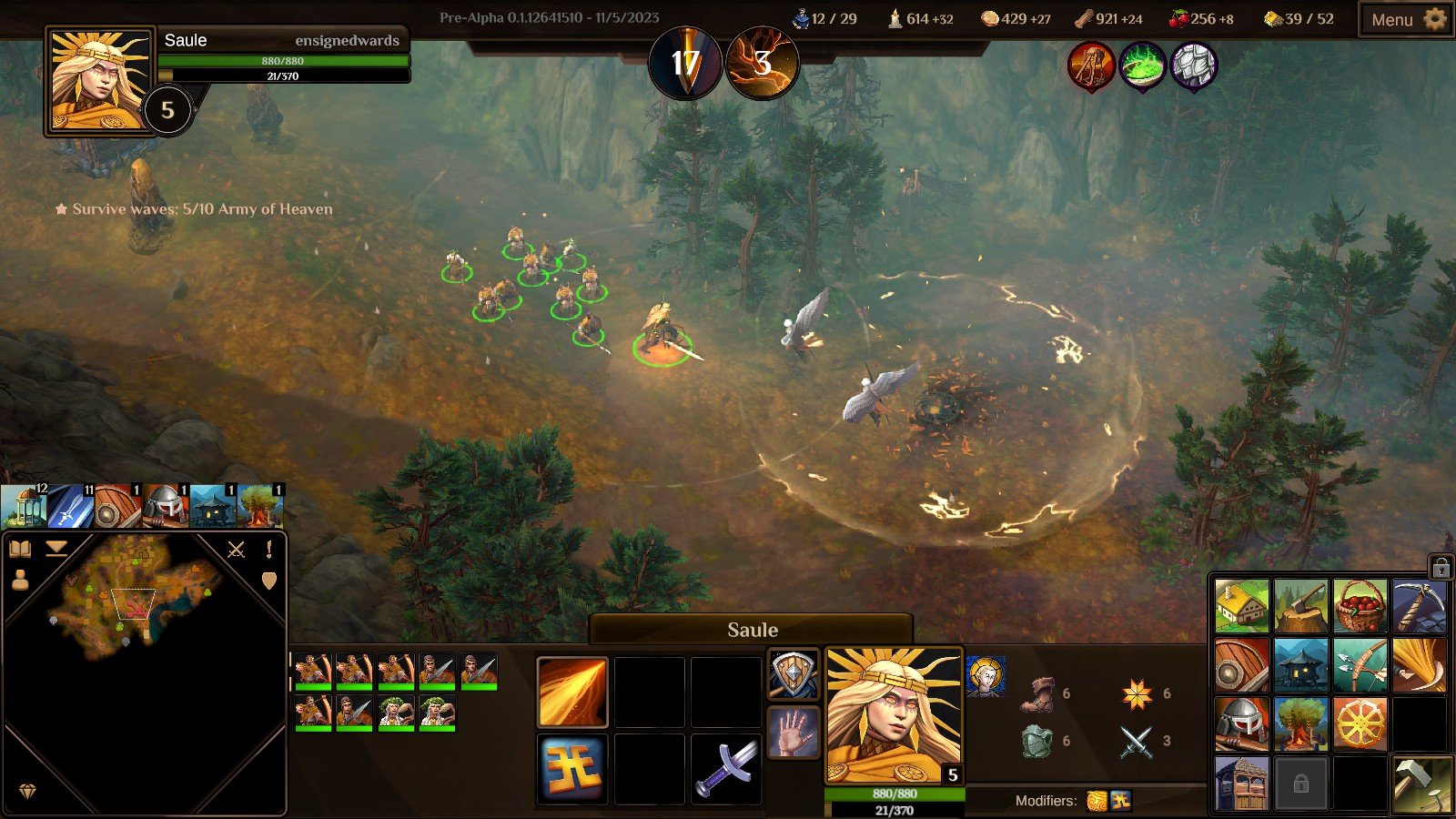
It’s a testament to how far the RTS genre has fallen that Steam’s recent Tacticon festival of strategy games featured almost no RTS titles, leaning more toward turn-based offerings. But there was one game that caught my eye: Thunderoak Interactive’s Godsworn, an RTS that seems like the offspring of both Warcraft III and Age of Mythology, two formative games of my childhood.
Tacticon has ended, but the pre-alpha demo of Godsworn will continue to be available until May 21st. Having played it, I’ve found Godsworn to be an incredibly promising game, even if it appears to be a long way from finished.
Produced by a team of just two developers, Godsworn depicts a highly fictionalized fantasy version of the Northern Crusades, a period in which Christian crusaders sought to stamp out paganism in the Baltic region. The finished game will have two factions representing the Baltic peoples and the crusaders, but the demo offered only the Baltic faction.
Godsworn‘s gameplay draws more from Warcraft III than anything else. At the start of the game, you’ll select a god, who functions as a hero unit. As in WC3, your god can earn experience to unlock new abilities and grow more powerful over the course of a match.
There are even camps of NPC creeps you can fight to level up, just as in the WC3 days. There’s no item system in Godsworn, but you can rescue captured villagers from the creeps, who will then join you as additional workers, and many creeps drop small caches of resources for a further economic boost.
You can’t gain additional heroes over the course of the match, but there are more abilities to unlock than there were in WC3. Interestingly, active abilities are split between abilities on the hero’s character card and global calldown abilities reminiscent of Age of Mythology‘s god powers.

Much of the rest of the gameplay carries similar WC3 vibes. Population limits are relatively low, and units tend to pretty beefy, making combat a fairly stately affair, with lots of room for back and forth, in contrast to the lightning fast and often unforgiving combat of something like StarCraft II. Even the art style is vibrant and colourful in the best tradition of Warcraft.
However, you can also see some strong inspirations from Age of Mythology, even beyond the obvious mythological setting. I’ve already mentioned the global god powers, but there’s much more to it than that.
Your choice of god doesn’t just change the hero unit you get. As in AoM, the god you choose to follow will also alter your technology tree.
In the demo, two gods of the Baltic faction were available: a sun goddess named Saule and a moon god called Meness. While they are shared some units in common, they also had their own unique units, as well as different upgrades for some of the units they did share.
The end result was radically different playstyles. Saule focused on tanky units and healing effects, making for a very stable, safe approach to combat. Meanwhile Meness had a much greater emphasis on squishy units with high damage and powerful crowd control abilities. High risk, high reward.
The economic mechanics are another area where Godsworn borrows from Age of Mythology‘s playbook. You have four resources to gather: faith, food, wood, and wealth. It’s not quite the same depth of macro mechanics seen in the Age games, but it does capture a bit of that soothing village building vibe they have.
I absolutely love both Warcraft III and Age of Mythology, so it’s really not a surprise that I took to Godsworn like a fish to water. But as I played more, I found that it’s not just aping the success of past games. It has some genuinely good ideas of its own.

What really impressed me about Godsworn was how many brilliant quality of life perks it has. So many of the more chore-like elements of the RTS genre have been smoothed over.
Villagers, for example, are automatically produced up to a certain limit as long as you have population room. One of the most tedious things about RTS games has always been producing workers at the start of the game, and having that done for you is such a relief.
The villagers are partially automated, as well. When a new one is produced, it automatically starts praying at your shrine to accrue faith. There’s also no need to select villagers in order to build new structures. You simply have a build menu at the side of the screen, and you can place buildings from it; a villager will then automatically go from the shrine to build it. If it’s a resource production building, the villagers will start working at it when they’re done building, but otherwise they’ll go back to praying. Say goodbye to idle worker time.
You can of course still issue orders to your villagers manually if you choose, but the mouse clicks and mental energy this level of automation saves is incredible.
One other QoL perk I found very helpful is that the audio notifications for when you’re running out of resources or population space happen slightly before you actually hit the limits, allowing you to respond promptly and ensure your economy is never slowed too much.
For the expert players who never get supply-blocked, this won’t make much difference, but for us mere mortals, it’s an incredibly helpful tool. This is one of those ideas that’s so good it seems unbelievable no one thought of it before.

With all that praise offered to Godsworn, I should note that the game is still a long, long way from being finished. The full game is planned to include a full campaign playable solo or in co-op, as well as the standard PvP options of an RTS, but the demo offered only custom games (PvP or versus AI) and a single PvE wave defence scenario.
While the gameplay was surprisingly polished all things considered, the text and tooltips were pretty rough, and the UI felt a little unfinished in places. The enemy AI also didn’t seem to know how to use its hero abilities, though it was reasonably intelligent otherwise.
The one issue I had with the game that couldn’t be blamed on it simply not being done yet is that I found most of the human units looked pretty similar and clumped up very tightly in battle, making it difficult to read what was going on in big fights. I’d like to see the collision size for units increased a bit so they don’t blob up so hard.
I’m hesitant to get myself too hyped with the game so far from completion. Godsworn is scheduled to launch into early access this year, but a full launch is likely farther down the road. The last time I got hyped for a Warcraft III spiritual successor it ended up dying before it even made it to full launch, and with such a small team, it feels like Godsworn has a long road ahead of it.
But as unfinished as it is, I am impressed by what Godsworn already has to offer. It’s clear the developers have a good understanding of and affection for the RTS genre, and they seem to have a solid plan to capture the greatness of the games of yesteryear while also modernizing their formulas.
I’m pretty strongly opposed to the concept of early access, but this is perhaps the first time I’ve felt tempted to buy in early just to support the devs. I like what they’re trying to do here.
 The world of online gaming is changing. As the gray area between single-player and MMO becomes ever wider, Massively OP’s Tyler Edwards delves into this new and expanding frontier biweekly in Not So Massively, our column on battle royales, OARPGs, looter-shooters, and other multiplayer online titles that aren’t quite MMORPGs.
The world of online gaming is changing. As the gray area between single-player and MMO becomes ever wider, Massively OP’s Tyler Edwards delves into this new and expanding frontier biweekly in Not So Massively, our column on battle royales, OARPGs, looter-shooters, and other multiplayer online titles that aren’t quite MMORPGs.














